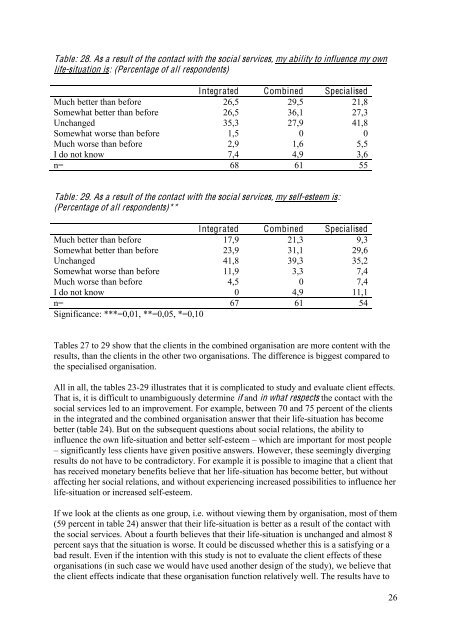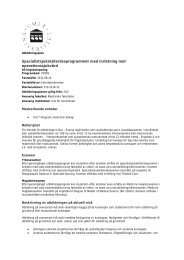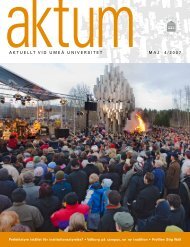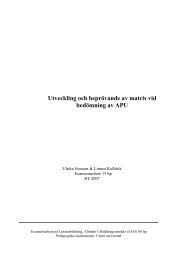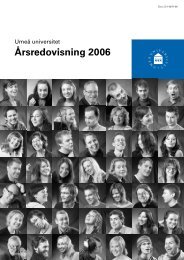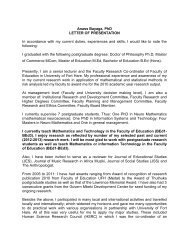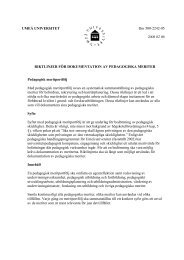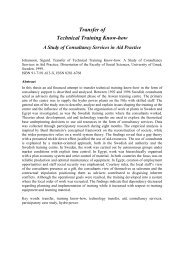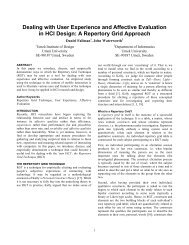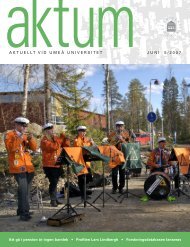Table: 28. As a result of <strong>the</strong> contact with <strong>the</strong> social services, my ability to <strong>in</strong>fluence my ownlife-situation is: (Percentage of all respondents)Integrated Comb<strong>in</strong>ed SpecialisedMuch better than bef<strong>or</strong>e 26,5 29,5 21,8Somewhat better than bef<strong>or</strong>e 26,5 36,1 27,3Unchanged 35,3 27,9 41,8Somewhat w<strong>or</strong>se than bef<strong>or</strong>e 1,5 0 0Much w<strong>or</strong>se than bef<strong>or</strong>e 2,9 1,6 5,5I do not know 7,4 4,9 3,6n= 68 61 55Table: 29. As a result of <strong>the</strong> contact with <strong>the</strong> social services, my self-esteem is:(Percentage of all respondents)**Integrated Comb<strong>in</strong>ed SpecialisedMuch better than bef<strong>or</strong>e 17,9 21,3 9,3Somewhat better than bef<strong>or</strong>e 23,9 31,1 29,6Unchanged 41,8 39,3 35,2Somewhat w<strong>or</strong>se than bef<strong>or</strong>e 11,9 3,3 7,4Much w<strong>or</strong>se than bef<strong>or</strong>e 4,5 0 7,4I do not know 0 4,9 11,1n= 67 61 54Significance: ***=0,01, **=0,05, *=0,10Tables 27 to 29 show that <strong>the</strong> clients <strong>in</strong> <strong>the</strong> comb<strong>in</strong>ed <strong>or</strong>ganisation are m<strong>or</strong>e content with <strong>the</strong>results, than <strong>the</strong> clients <strong>in</strong> <strong>the</strong> o<strong>the</strong>r two <strong>or</strong>ganisations. The difference is biggest compared to<strong>the</strong> specialised <strong>or</strong>ganisation.All <strong>in</strong> all, <strong>the</strong> tables 23-29 illustrates that it is complicated to study and evaluate client effects.That is, it is difficult to unambiguously determ<strong>in</strong>e if and <strong>in</strong> what respects <strong>the</strong> contact with <strong>the</strong>social services led to an improvement. F<strong>or</strong> example, between 70 and 75 percent of <strong>the</strong> clients<strong>in</strong> <strong>the</strong> <strong>in</strong>tegrated and <strong>the</strong> comb<strong>in</strong>ed <strong>or</strong>ganisation answer that <strong>the</strong>ir life-situation h<strong>as</strong> becomebetter (table 24). But on <strong>the</strong> subsequent questions about social relations, <strong>the</strong> ability to<strong>in</strong>fluence <strong>the</strong> own life-situation and better self-esteem – which are imp<strong>or</strong>tant f<strong>or</strong> most people– significantly less clients have given positive answers. However, <strong>the</strong>se seem<strong>in</strong>gly diverg<strong>in</strong>gresults do not have to be contradict<strong>or</strong>y. F<strong>or</strong> example it is possible to imag<strong>in</strong>e that a client thath<strong>as</strong> received monetary benefits believe that her life-situation h<strong>as</strong> become better, but withoutaffect<strong>in</strong>g her social relations, and without experienc<strong>in</strong>g <strong>in</strong>cre<strong>as</strong>ed possibilities to <strong>in</strong>fluence herlife-situation <strong>or</strong> <strong>in</strong>cre<strong>as</strong>ed self-esteem.If we look at <strong>the</strong> clients <strong>as</strong> one group, i.e. without view<strong>in</strong>g <strong>the</strong>m by <strong>or</strong>ganisation, most of <strong>the</strong>m(59 percent <strong>in</strong> table 24) answer that <strong>the</strong>ir life-situation is better <strong>as</strong> a result of <strong>the</strong> contact with<strong>the</strong> social services. About a fourth believes that <strong>the</strong>ir life-situation is unchanged and almost 8percent says that <strong>the</strong> situation is w<strong>or</strong>se. It could be discussed whe<strong>the</strong>r this is a satisfy<strong>in</strong>g <strong>or</strong> abad result. Even if <strong>the</strong> <strong>in</strong>tention with this study is not to evaluate <strong>the</strong> client effects of <strong>the</strong>se<strong>or</strong>ganisations (<strong>in</strong> such c<strong>as</strong>e we would have used ano<strong>the</strong>r design of <strong>the</strong> study), we believe that<strong>the</strong> client effects <strong>in</strong>dicate that <strong>the</strong>se <strong>or</strong>ganisation function relatively well. The results have to26
e related to <strong>the</strong> fact that <strong>the</strong> PSS often w<strong>or</strong>k with people with very difficult problems (e.g.drug abuse, child abuse, racial conflicts, which have aggravated under long periods). Thusone cannot expect that all clients at a certa<strong>in</strong> occ<strong>as</strong>ion (i.e. <strong>the</strong> period when <strong>the</strong> questionnairew<strong>as</strong> distributed) answers that <strong>the</strong> contact h<strong>as</strong> led to an improvement. M<strong>or</strong>eover, from ourprevious studies (Blom & M<strong>or</strong>én, 2007, M<strong>or</strong>én & Blom, 2003) we know that clients dur<strong>in</strong>g<strong>the</strong> <strong>in</strong>itial ph<strong>as</strong>e of <strong>the</strong> contact with <strong>the</strong> PSS can feel that life h<strong>as</strong> become w<strong>or</strong>se, e.g. because<strong>the</strong>y have to quit abus<strong>in</strong>g drugs. Maybe that is one of <strong>the</strong> re<strong>as</strong>ons way so many <strong>as</strong> 16 percentof <strong>the</strong> clients <strong>in</strong> <strong>the</strong> <strong>in</strong>tegrated <strong>or</strong>ganisation believe that <strong>the</strong>ir self-esteem (table 29) is w<strong>or</strong>se <strong>as</strong>a result of <strong>the</strong> social services. It could – how strange this may seem – be an <strong>in</strong>dication ofsuccessful social w<strong>or</strong>k.Summ<strong>in</strong>g-upTaken <strong>as</strong> a whole, <strong>the</strong> results show – almost throughout – that clients <strong>in</strong> <strong>the</strong> <strong>in</strong>tegrated<strong>or</strong>ganisation, compared to <strong>the</strong> clients <strong>in</strong> <strong>the</strong> comb<strong>in</strong>ed and <strong>the</strong> specialised <strong>or</strong>ganisation:- have had contacts with fewer social w<strong>or</strong>kers and units with<strong>in</strong> <strong>the</strong> PSS- have experienced <strong>the</strong> PSS’ <strong>in</strong>ternal and external cooperation <strong>as</strong> better- have experienced <strong>the</strong> social w<strong>or</strong>kers holistic view and responsibility <strong>as</strong> better- have received a better encounter/treatment and been m<strong>or</strong>e <strong>in</strong>volved <strong>in</strong> <strong>the</strong> help<strong>in</strong>g process- are m<strong>or</strong>e satisfied with <strong>the</strong> results (except that clients <strong>in</strong> <strong>the</strong> comb<strong>in</strong>ed <strong>or</strong>ganisation are m<strong>or</strong>esatisfied <strong>in</strong> some respects, cp. tables 27-29)- seem to have understood <strong>the</strong> PSS-<strong>or</strong>ganisation, <strong>the</strong> help<strong>in</strong>g process and <strong>the</strong>ir own situation<strong>in</strong> a better way (fewer clients have answered I do not know on questions about concretecircumstances <strong>as</strong> well on questions concern<strong>in</strong>g attitudes).Hence, <strong>the</strong>re are a number of significant differences between <strong>the</strong> clients <strong>in</strong> <strong>the</strong> studiedmunicipalities, which can be related to how <strong>the</strong> PSS is <strong>or</strong>ganised. The results <strong>in</strong>dicate that <strong>the</strong><strong>in</strong>tegrated <strong>or</strong>ganisation is <strong>the</strong> most advantageous (<strong>or</strong> less disadvantageous) from a clientperspective. Anew we want to emph<strong>as</strong>ize that <strong>the</strong> results h<strong>as</strong> to be <strong>in</strong>terpreted carefully,consider<strong>in</strong>g that <strong>the</strong> sample w<strong>as</strong> not fully randomized and <strong>the</strong> limited number of respondents.Never<strong>the</strong>less, due to <strong>the</strong> fact that <strong>the</strong> results from <strong>the</strong> client study are fully <strong>in</strong> l<strong>in</strong>e with <strong>the</strong>results from <strong>the</strong> o<strong>the</strong>r studies with<strong>in</strong> <strong>the</strong> project (studies of social w<strong>or</strong>kers, politicians andsuperi<strong>or</strong>s) 12 , we regard <strong>the</strong> reliability of <strong>the</strong> study <strong>as</strong> acceptable.The focus of this paper is if <strong>or</strong>ganisational structure is a barrier <strong>or</strong> supp<strong>or</strong>t f<strong>or</strong> clients <strong>in</strong> <strong>the</strong>personal social service, and m<strong>or</strong>e specifically whe<strong>the</strong>r this depends on <strong>the</strong> type of<strong>or</strong>ganisation. B<strong>as</strong>ed on <strong>the</strong> results presented above, we discuss this question <strong>in</strong> <strong>the</strong> next part of<strong>the</strong> paper.The PSS <strong>as</strong> barrier <strong>or</strong> supp<strong>or</strong>t?In <strong>the</strong> title of this paper we put f<strong>or</strong>ward <strong>the</strong> question if <strong>or</strong>ganisational structure is a barrier <strong>or</strong>supp<strong>or</strong>t <strong>in</strong> <strong>the</strong> personal social services. Generally regarded, <strong>the</strong> obvious answer is that <strong>the</strong>PSS’ <strong>or</strong>ganisational structure function <strong>as</strong> supp<strong>or</strong>t <strong>as</strong> well <strong>as</strong> barrier, irrespective of which<strong>or</strong>ganisational model one have <strong>in</strong> m<strong>in</strong>d. The answer on that question, among o<strong>the</strong>r th<strong>in</strong>gs,depends on who’s’ perspective (e.g. politicians’, social w<strong>or</strong>kers’ <strong>or</strong> clients’) <strong>the</strong> matter isviewed from, what one mean by supp<strong>or</strong>t and barrier (e.g. f<strong>or</strong> management <strong>or</strong> <strong>in</strong>terventions),and what <strong>or</strong>ganisational t<strong>as</strong>ks that is <strong>in</strong> focus (e.g. prevention, treatment <strong>or</strong> care).12 M<strong>or</strong>én, S., Blom, B., Lundgren, M. & Perl<strong>in</strong>ski, M. (f<strong>or</strong>thcom<strong>in</strong>g); Perl<strong>in</strong>ski, Blom & M<strong>or</strong>én (2009);Perl<strong>in</strong>ski, Blom, M<strong>or</strong>én & Lundgren (f<strong>or</strong>thcom<strong>in</strong>g).27


